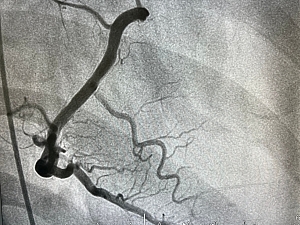In the ACUITY trial, published in NEJM, bivalirudin demonstrated a significant reduction in major bleeding compared with heparin in patients with non–ST segment–elevation acute coronary syndromes undergoing percutaneous coronary intervention (PCI). However, subsequent randomized controlled trials have had mixed results, probably because of methodological differences.
To characterize the relative safety and effectiveness of the two antithrombin agents in this setting, Behnood Bikdeli, MD, MS, a clinician–investigator in the Division of Cardiovascular Medicine and Thrombosis Research Group at Brigham and Women’s Hospital, and colleagues conducted a patient-level meta-analysis of ACUITY plus four other large randomized trials.
In Circulation, the study reported that bivalirudin was not associated with any significant difference in 30-day effectiveness outcomes or mortality compared with heparin, but had a substantially better safety profile.
Methods
As previously reported in Thrombosis and Haemostasis, all five trials included at least 1,000 patients. Independently adjudicated clinical outcomes were pooled in a common database in a rigorous process that took nearly four years (December 2015 to September 2019), and analyses were performed according to a prespecified protocol before data unblinding.
The current analysis included 12,155 qualifying patients with non–ST segment–elevation myocardial infarction (NSTEMI) undergoing PCI who were randomly assigned to bivalirudin with or without a post-PCI bivalirudin infusion or heparin (unfractionated or low-molecular-weight) with or without planned use of a glycoprotein IIb/IIIa inhibitor (GPI).
Efficacy
There was no difference between the bivalirudin and heparin groups on the primary endpoint, the 30-day rate of all-cause mortality (1.2% vs. 1.1%; adjusted OR, 1.24; P=0.25).
In addition, there were no significant differences between groups in 30-day rates of cardiac mortality, re-infarction, clinically driven target vessel revascularization, stroke, stent thrombosis, or major adverse cardiovascular and cerebrovascular events.
One-year results were consistent with the 30-day outcomes.
Safety
Patients randomized to bivalirudin versus heparin had lower odds of serious bleeding (3.3% vs. 5.3%; aOR, 0.59; P<0.0001). The rates were significantly lower at both the vascular access site and non-access site bleeding events. As a result, net adverse clinical events (a measure of net clinical benefit) were reduced with bivalirudin (12.8% vs. 14.1%; aOR, 0.88; P=0.027).
Bivalirudin use also resulted in significantly lower rates of blood transfusions and thrombocytopenia.
Results According to Bivalirudin Infusion and GPI Use
30-day and 1-year mortality rates did not significantly differ between the two agents, regardless of whether a bivalirudin infusion or GPI use with heparin was planned or provisional.
The reduction in serious bleeding with bivalirudin was somewhat mitigated when a GPI wasn’t used routinely with heparin, but it was still evident.
For most outcomes, the results with bivalirudin were not affected by using a post-PCI bivalirudin infusion. However, unexpectedly, bivalirudin use with a high-dose infusion was associated with an increased 30-day risk of stroke compared with heparin alone (0.5% vs. 0.2%; aOR, 4.10; P=0.005). This finding should be interpreted with caution because it was derived from data from only three of the five trials (32% of patients), the frequency of stroke was low, there was no adjustment for multiple comparisons, and no plausible mechanism is known. Regardless, neither high-dose nor low-dose post-PCI bivalirudin infusion reduced ischemic event rates compared with procedural-only use of bivalirudin.
Recommendations for Interventionists
The key takeaways from this meta-analysis are:
- Heparin without planned GPI use or bivalirudin without a post-PCI infusion appears to be equally effective for patients with NSTEMI undergoing PCI
- Of those two anticoagulation regimens, bivalirudin without post-PCI infusion may be preferred because of its better safety profile
- Post-PCI bivalirudin infusion is not recommended for patients with NSTEMI (for patients with STEMI, two of the five trials associated post-PCI high-dose bivalirudin with reduced stent thrombosis rates and possibly improved survival without increasing bleeding, which were independently verified in a separate trial)
